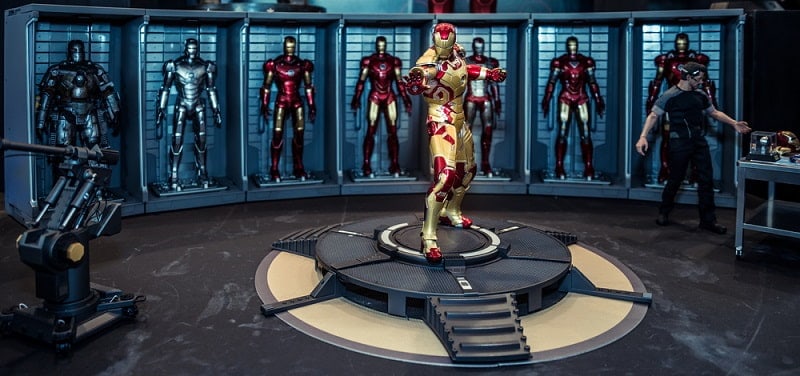Iron Man was one of the most impressive heroes of the Marvel Cinematic Universe (MCU). He was only human, so he didn’t have any magical powers; that said, his intellect was second to none, and he used it to create his iconic armored suits.
These suits allowed him to perform all kinds of crazy feats, such as flying, having superhuman strength, the ability to heal himself, and even to repair the suit and create weapons on the fly.
So, how realistic was Iron Man’s suit? Could we make something like it in real life?
Iron Man’s suit breaks various laws of physics, so it is quite unrealistic according to what we currently know about science and technology. That said, using real-world scientific principles, we can create suits that allow similar abilities, such as flight and enhanced strength.
Contents
How Realistic Is Iron Man’s Suit?

Throughout various movies of the Marvel Cinematic Universe, Tony Stark sported twelve different suits–many more in the comics.
With each new suit, he made changes and improvements to increase the functionality of the suit. The technologies he used became more and more impressive over time.
But were these suits realistic? Could we recreate them in the real world?
Many people recognize that an exact, functioning replica of any of Iron Man’s suits would be impossible to create. Why? Some of the science simply doesn’t add up.
For example, the Arc reactor that powers all of Iron Man’s suits is a soda-can-sized power source implanted in Tony’s chest. There are a number of problems with this power source alone.
For one thing, it would have displaced too many important organs in Tony’s chest–organs such as the heart and lungs. He couldn’t have survived with this kind of organ displacement.
Secondly, the Arc reactor produces an incredible amount of energy. Even the most efficient power source would create a lot of heat waste due to this energy production–so much so that it would kill the person wearing the suit.
Finally, the sheer amount of energy produced by the Arc reactor is equivalent to what is produced by three nuclear power plants. Remember, all of this power comes from something the size of a soda can.
We simply don’t have that kind of technology. At least, it hasn’t been discovered yet.
In addition, the repulsor beams that Iron Man shoots out of his hands seem to defy the laws of physics, which state that “for every action, there is an equal and opposite reaction.” It is this principle that causes a gun to recoil when it is fired.
Iron Man should have been flung backward by the force every time he shot these reactor beams, but he wasn’t.
There are other things about Iron Man’s suits that aren’t realistic.
He is able to fly horizontally without creating any downward lift. The rockets from his feet can launch him vertically, but they would not be able to keep him in the air once he goes horizontal.
He is able to survive ridiculous amounts of blunt force trauma and the g-forces from sudden movements, but there is nothing to indicate how his suit protects him from these impacts.
This might make sense if it were made of vibranium, which absorbs kinetic energy; but Tony never used vibranium in any of his suits.
Finally, the nanotechnology used in some of his more advanced suits, though not entirely outside the realm of possibility, is far beyond any technology we currently have access to in real life.
Can the Iron Man Suit Be Made in Real Life?

Judging by the section above, you may think it would be completely impossible to make a real Iron Man suit. And you would be correct–at least partially.
While it’s impossible to create an exact replica of any one Iron Man suit, there are elements that Tony used in the construction of his suits that could be recreated in real life.
In fact, several such efforts have been made, with varying degrees of success.
First, Raytheon created a couple of versions of the XOS, a tethered exoskeleton that allows the wearer enhanced strength and lifting capabilities.
A similar, untethered exoskeleton known as HULC was created by Lockheed Martin.
Efforts have also been made at creating wearable flying devices, such as jetpacks.
One of these has even come to be known as the “real life Iron Man suit” and is available to buy for nearly half a million dollars.
Again, none of these fully compare to the Iron Man suits of the movies. They don’t incorporate such elements as Arc reactors, repulsor beams, and nanotechnology.
But they do share some similarities with the technological masterpieces that Tony Stark was known for creating.
Are Iron Man’s Suits Actually Made of Iron?

This would only make sense, right?
He’s called “Iron Man”, and his armored suits are clearly made out of some type of metal, so it’s easy to assume that the metal he used was iron.
However, this is not the case.
Tony Stark used various materials to create the different versions of his suit, and most of them were metal alloys.
He commonly used titanium and titanium alloys due to the strength, durability, and relatively light weight of this metal.
He also incorporated gold and gold alloys.
Iron would not have been a practical choice for his suits because it is a relatively heavy metal. It also rusts easily and isn’t as strong as other metals.
So, if he didn’t use iron in his suits, why was he called Iron Man?
In the MCU, he was given that name by the media, who may have assumed the suit was made of iron. They may have also been referencing the term “ironman”, which is used to describe a man who is particularly strong or robust.
Conclusion
Iron Man’s suits incorporate various technologies that simply aren’t realistic according to what we currently know about the laws of physics. Some of these technologies are theoretically possible, but we don’t yet have them available in the real world.
That said, efforts have been made to create suits and exoskeletons that have some similar abilities to what we see in the movies.
Finally, though he was called Iron Man, Tony Stark’s suits were not made of iron. Instead, he used stronger and more lightweight metals such as titanium alloys.

Sarah Hood is a freelance content writer and editor with a love for all things Star Wars. When she’s not writing, she enjoys cooking, singing, and spending time in the great outdoors.
